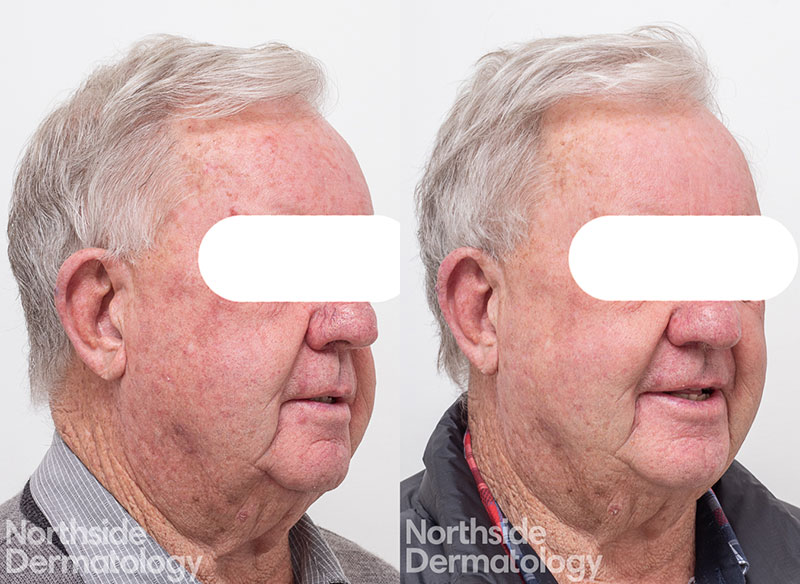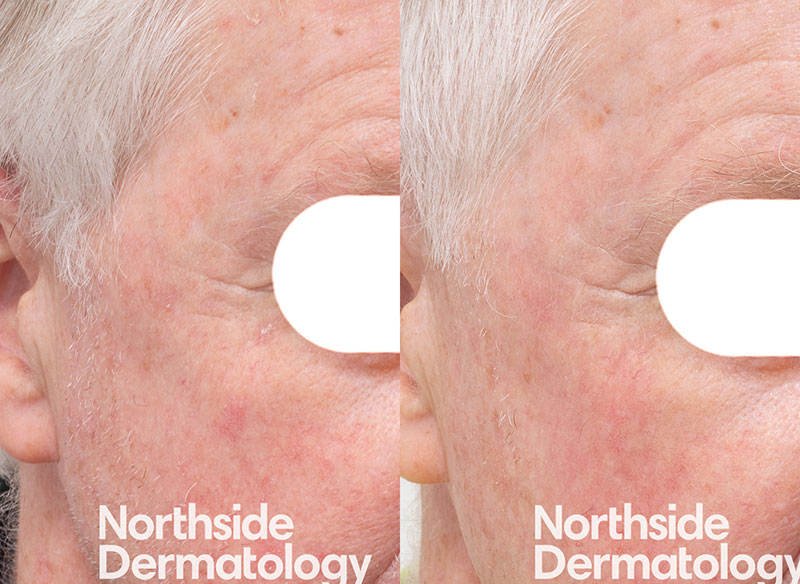
Laser PDT
Laser PDT
Sun exposure gives rise to many of the visible changes of ageing skin, as well as skin cancers and precancerous spots. Patients have numerous options for rejuvenating sun-damaged skin and both surgical and nonsurgical approaches for treating concerning lesions and skin cancers. For those who want to address medical sun damage and cosmetic signs of sun damage simultaneously, laser PDT offers superior results with reduced downtime.
Before & After
Before and 4 weeks after 1 session with laser PDT for medical and cosmetic signs of sun damage. Note the clearance of his sun spots, disappearance of nasal vessels, and the overall improvement in facial dyschromia and facial redness.

Actual patient of Northside Dermatology. Photos are taken with our standardised clinical photography system and published with patient’s consent. Individual results may vary. A thorough consultation is required prior.
Before and after 1 treatment with PDT for precancerous sun spots.

Actual patient of Northside Dermatology. Photos are taken with our standardised clinical photography system and published with patient’s consent. Individual results may vary. A thorough consultation is required prior.
What is Laser PDT?
Laser PDT is a dermatologist-developed technique that combines co2 laser and/or laser for redness, laser for pigment and PDT. By blending these three potent modalities together, laser PDT patients receive the cosmetic benefits of treating vascular imperfections, pigmentary irregularities with the medical benefits of PDT in one procedure. Laser PDT can be used to treat solar keratoses (also known as actinic keratoses or AKs, precancerous lesions in the outer skin layer caused by excessive exposure to ultraviolet light), liver spots, redness, broken capillaries and sebaceous hyperplasia.
What are the advantages of Laser PDT?
The synergistic combination of lasers for redness, laser for pigment with PDT can improve the appearance texture of sun-damaged skin and treat precancerous lesions simultaneously. Laser PDT achieves better results than either treatment alone and does so without additional downtime.
The advantages of Laser PDT include:
- Treatment can be conducted throughout the year
- Better cosmetic outcomes than surgical removal of premalignant and malignant lesions
- Significantly shorter recovery time than topical fluorouracil cream for the treatment of superficial precancerous and cancerous spots
- Can treat a larger area with multiple lesions rather treating isolated lesions individually
- More convenient for a busy schedule than two treatments performed separately
Is Laser PDT painful?
The discomfort experienced during laser PDT is similar to the discomfort experienced during treatment with PDT or vascular lasers. The procedure is generally well-tolerated, but it can be uncomfortable for some patients. You may feel sensations of tingling, burning or stinging while the treatment is administered. Most individuals do not require anaesthesia to undergo laser PDT, but if you are concerned about pain, your clinician can discuss options that will provide you with a greater degree of comfort during the treatment.
What is the downtime associated with Laser PDT?
Downtime after a laser PDT session lasts approximately 7 to 10 days. During this time, your skin may feel as though it has been sunburnt. You can expect some discomfort, redness, swelling and scabbing, followed by a period of peeling. Your skin will be light-sensitive and should be carefully protected from the sun for the week after the treatment. After the peeling phase is complete, the damaged skin will be eliminated and you will be left with smoother, more even and younger-looking skin.
What is CO2-assisted photodynamic therapy (PDT)?
CO2-assisted photodynamic therapy (PDT) is when the CO2 laser is combined with PDT to enhance the deeper delivery of the photosensitizing agent into target tissues, hence increasing the efficacy of the treatment. This method is beneficial when treating the more persistent precancerous sun spots on the face. Be guided by our dermatologist when this is appropriate.
How do I look after my skin post Laser PDT treatment or CO2 assisted PDT?
Appropriate aftercare should be discussed with your dermatologist.
Cleanser:
You will need to use a gentle cleanser such as Cetaphil wash or salt water twice daily.
Moisturise:
Moisturise throughout the day to help to alleviate the tightness and peeling of the skin. Use Cicaplast (La Roche Posay) or Vaseline.
Pain relief:
Take a regular paracetamol for the first couple of days post treatment if you are experiencing discomfort.
Keep a wet towel in the freezer, and use this to help to alleviate the burning sensation intermittently.
Keep your moisturising cream such as Cetaphil, Cicaplast or Vaseline in the fridge so that you can apply to the peeling areas on the skin.
Sun Protection:
Protect your skin from the sunlight by wearing a broad brimmed hat, use zinc based SPF 50+ sunscreen regularly and reapply every few hours post treatment. You will be extra sensitive to the sunlight for the first 2 days after treatment.
Anti— inflammatory cream:
If you are experiencing lots of redness/burning post treatment, you can use 1% Sigmacort ointment (an over the counter mild steroid ointment) twice daily to settle down the inflammation. For more excessive inflammation, your doctor may prescribe an anti inflammatory ointment to be used twice daily for 5 days to settle the reaction.
Make up:
You can resume your usual make up after 2 days of treatment
Skin care/ cosmeceutical creams
Use Cicaplast or Vaseline only for the first 1 week post treatment. You can restart on your usual skin care including cosmeceutical creams after the first week. Do not introduce these if your skin is still feeling sensitive. Always protect your skin with sunscreen.
Laser PDT can be an excellent option for patients who value effective treatment and excellent cosmetic outcomes, and who wish to avoid an invasive procedure or extensive downtime. A consultation with a consultant dermatologist is required to determine whether laser PDT is right for you. Call Northside Dermatology on 03 8582 8688 today to book your appointment.
Send us a message
Contact Us
Hours of Operation
Monday - Friday, 9am-5pm
Phone Number
Fax Number
Emails
Medical Enquiries:
reception@northsidedermatology.com.auLaser & Cosmetic Enquiries:
cosmetic@northsidedermatology.com.au